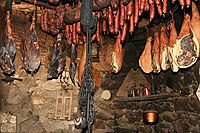
Photo from wikipedia
Traditional pear cultivars are increasingly in demand by consumers because of their excellent taste, the possibility of use in sustainable food production systems, convenience as raw materials for obtaining products… Click to show full abstract
Traditional pear cultivars are increasingly in demand by consumers because of their excellent taste, the possibility of use in sustainable food production systems, convenience as raw materials for obtaining products of high nutritional quality, and perceived health benefits. In this study, individual sugars, organic acids, and polyphenols in the fruits of nine traditional and one commercial pear cultivar during two growing seasons were determined by HPLC. A significant influence of cultivars, growing years, and their interaction on the content of analyzed primary and secondary metabolites was determined. The commercial pear cultivar ‘Président Drouard’ and traditional cultivars ‘Dolokrahan’, ‘Budaljača’, and ‘Krakača’ had a lower content of all analyzed sugars. Overall, traditional pear cultivars had higher total polyphenols in the peel and pulp than ‘Président Drouard’, with the exception ‘Takiša’ and ‘Ahmetova’. High polyphenol content detected in ‘Budaljača’, ‘Dolokrahan’, and ‘Krakača’ shows the utilization value of traditional pear germplasm. The obtained data can serve as practical supporting data for the use of traditional pears in the neutraceutical, pharmaceutical, and food industries.
Journal Title: Foods
Year Published: 2022
Link to full text (if available)
Share on Social Media: Sign Up to like & get
recommendations!